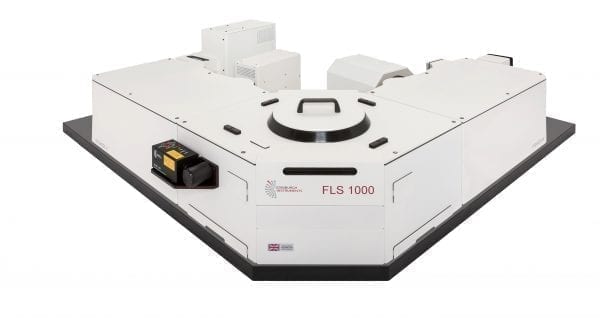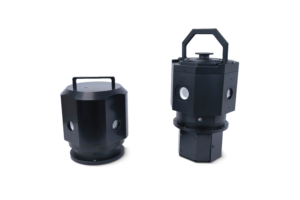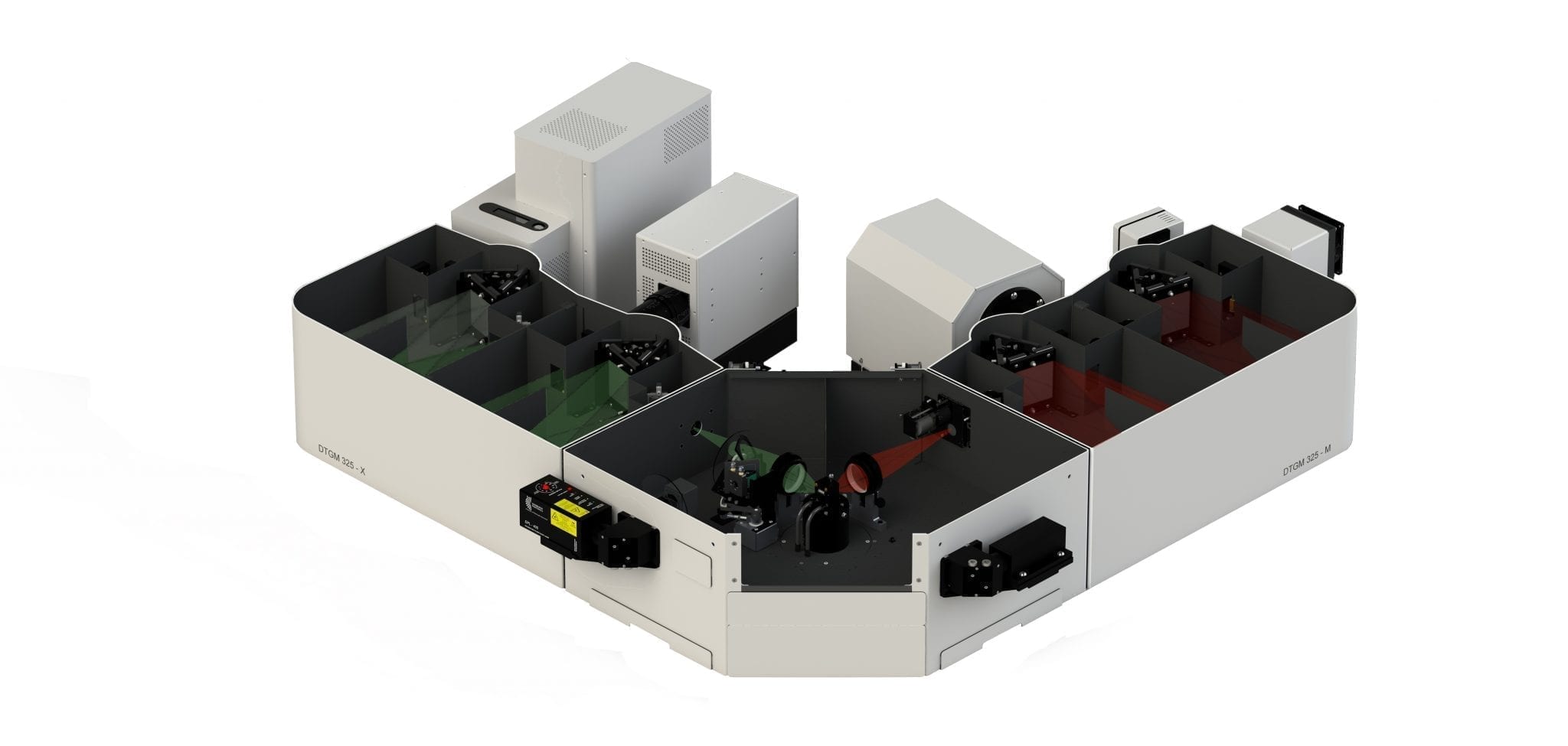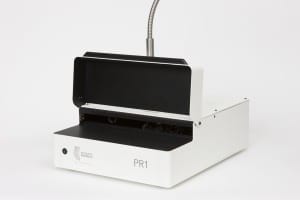
FLS1000 Upgrades
The upgrade options are modifications or additions to the main body of the FLS1000. All upgrades are best installed at the time of manufacture, but they can also be retro-fitted by a qualified service engineer during an on-site visit.
Configuration Upgrades
Double Monochromators
Our systems can be equipped with double monochromators on excitation and emission arms. Double monochromators are recommended for highly scattering, low emissive samples as they improve the systems stray light suppression and increase the signal-to-noise ratio. A double monochromator in the emission arm allows for up to three detectors mounted simultaneously with software-based selection; two detectors can be fitted after the double monochromator and one after the first of the two monochromators. All monochromators are 325 mm focal length.
Geometries
If further detectors are required, the system can be configured in a T-geometry (pictured above) by the addition of a separate emission monochromator. This configuration can also be useful to provide a digital detection arm and an analogue detection arm.
Light Source Upgrades
Xenon Lamps
450 W continuous wavelength lamps for steady state measurements. The excitation range is typically 230 nm to >1700 nm. Ozone generating lamps may be used to increase the lower range to 180 nm.
Microsecond Flashlamp
μF1 and μF2: 5 W or 60 W pulsed xenon microsecond flashlamps producing short microsecond pulses for phosphorescence decay measurements. The excitation range is typically 230 nm to 1000 nm.
Ultrafast Nanosecond Flashlamp
nF980: ultrafast nanosecond flashlamp for time-resolved fluorescence studies with decays of 100 ps – 50 us. The excitation range is gas depedent.
Picosecond Pulsed Diode Lasers and LEDs
We manufacture a range of picosecond pulsed laser diodes (EPL Series) and pulsed LEDs (EPLED Series) for Time Correlated Single Photon Counting (TCSPC) measurements. Diodes are available over the UV-VIS spectrum starting at 250 nm and are pre-set with a range of repetition frequencies. The driver electronics are built into the light sources, eliminating the need for additional driver boxes and feature true „plug-and-play“ usability.
Continuous Wave (CW) Lasers
Various continuous wave lasers for use with the FLS Series and FS5 are available. Some CW laser sources may also be pulsed by the spectrometer to allow, for example, upconversion decays with 808 nm and 980 nm excitation to be measured.
Monochromator Options
Diffraction Gratings
The monochromators have triple grating turrets allowing up to three diffraction gratings to be permanently mounted within the monochromator. Standard gratings are generally chosen to cover the wavelength range of the detector. However, should you have more stringent requirements, such as requiring finer linear dispersion or an extended wavelength range, other diffraction gratings are available.
We can offer diffraction gratings with a groove density of 150 g/mm up to >1800 g/mm which allows us to cover the range 200 nm – 8000 nm.
Detector Options
Photomultiplier Tubes (PMTs)
Single photon counting detectors comprise a single photon counting photomultiplier, together with an optimised dynode chain, mounted in a light tight cooled or un-cooled housing. The detectors include the coupling flange with the adaptive optics for direct compatibility with all of Edinburgh Instruments‘ spectrometers.
The following PMTs are available: Standard PMTs up to 1010 nm, High speed PMTs up to 850 nm, MCP-PMT up to 850 nm, NIR-PMTs up to 1700 nm and gated PMTs.
Analogue Detectors
Analogue detectors are used either for high light level applications with the requirement for high dynamic range, or as alternative detectors in spectral ranges where photomultipliers are unavailable or too expensive. Depending on the required application, the analogue detectors come in a variety of housings with a variety of cooling options. Analogue detectors find application either in the FLS or the LP spectrometers to extend the spectral coverage into the NIR to 5.5 µm.
We offer detector assemblies that are supplied with PIN diodes with an active area of 3 mm. For steady state fluorescence applications the diode is mounted in a two stage TE cooled housing with collection/focusing optics chopper and lock-in. For time-resolved fluorescence or time-resolved phosphorescence applications, the diode is supplied in a two stage TE-cooled housing and with a digitising oscilloscope for data collection and averaging. The spectrometer’s software automatically downloads the data to allow automated measurements such as TRES and for further analysis and fitting.
Fluorescence Lifetime Upgrades
TCSPC Electronics
The TCC2 is an electronics module with USB interface, which incorporates all the electronic modules required for Time-Correlated Single Photon Counting (TCSPC) and Multi-Channel Scaling (MCS). This includes constant fraction discriminators, variable delays, time to amplitude converter and a large memory for multi-channel analysis.
– TSCPC time range: 2.5 ns – 50 μs full scale, MCS time range: 10 μs – 200 s full scale
– Time resolution from 305 fs/channel with ultra-low time jitter of 20 ps
For full technical specifications please contact us
Phosphorescence Lifetime Upgrades
MCS Electronics
The CB1 multichannel scaler.
– 100 MHz counter for spectral measurements (up to 3 channels)
– 10 ns minimum bin width in time-resolved measurements
– variable threshold settings
For full technical specifications please contact us
Sample Holder Options
Liquids
Single Cuvette Holder: Temperature adjustable by water/coolant circulation, fitted with integrated probe for sample temperature monitoring by spectrometer operating software. Filter slots provided for holding 50 mm square filters. This sample holder is included as part of the standard system.
Magnetic Stirrer: Magnetic Stirrer to be fitted to single cuvette holder or 3-position sample turret. The stirrer comprises three stirrer bars and a stand-alone stirrer controller.
Powders, Thin-Films and Solids
Front-Face Sample Holders: A range of single position front-face sample holders are available for powders, thin-films and solids. These include linear staged holders, rotational holders and clamps. Please contact us for more information.
Multiple Position Holders
3-Position Sample Turret: Computer-controlled 3-Position Cuvette Holder on rotational stage. All three positions temperature adjustable by water/coolant circulation, with an integrated temperature probe for sample temperature monitoring by spectrometer operating software.
Temperature Control Options
Bath/Refrigerator (-10°C – +100°C): Closed cycle water/coolant bath to be used with water-cooled sample holders. The temperature range is -10°C to +100°C. The unit comprises digital display of set and measured temperature. The temperature range at the sample position can be reduced depending on the length and the insulation of the coolant pipes used.
EPR Dewar (77 K): Liquid nitrogen dewar (quartz) in mounting collar for FLS1000 sample chamber with light tight seal, directly compatible to the sample chamber access flange. The dewar housing has a removable lid and built-in filter holders. Two individual EPR quartz sample rods supplied. Sample rod, containing the sample, will be immersed into the liquid nitrogen bath thus cooling the sample to 77K.
Liquid Nitrogen Cryostat (77 K – 300 K): Oxford Instruments liquid nitrogen cryostat, OptistatDN. The assembly comprises the cryostat head, the temperature controller, and a mounting flange and pedestal, directly compatible to the FLS1000 sample holder socket. Includes heater and sensor, cuvette holder, optical sample holder and sample rod. Spectrosil B quartz windows in L-geometry are used. Cryostat can be fully controlled by computer and Fluoracle® software.
Note: Special cryostat versions with windows arranged in T- or X-geometry are available on request.
Liquid Helium Cryostat (3.4 K – 300 K): Oxford Instruments liquid helium cryostat, OptistatCF. The assembly comprises the cryostat head, the temperature controller, transfer tube and SV12 adaptor, VC31 gas flow controller, GF4 pump, and a mounting flange and pedestal that is directly compatible to the FLS1000 holder socket. Includes heater and sensor, cuvette holder, optical sample holder and sample rod. Spectrosil B quartz windows in L-geometry are used. Cryostat can be fully controlled by computer and Fluoracle software.
Note: Special cryostat versions with windows arranged in T or X-geometry are available on request.
Liquid Helium Cryostat Extended Temperature Range (3.4 K – 500 K): Oxford Instruments extended temperature range liquid helium cryostat, OptistatCF. The assembly comprises the cryostat head, the ITC503 temperature controller, the LLT600 transfer tube and SV12 adaptor, VC31 gas flow controller, GF4 pump, and a mounting flange and pedestal that is directly compatible to the FLS1000 holder socket. All other inclusions as the standard liquid helium cryostat.
Note: Special cryostat versions with windows arranged in T or X-geometry are available on request.
Closed Cycle Cryostat Options: (4 K – 300 K, 10 K – 325 K, 6 K – 800 K): Includes helium compressor and hoses, sample exchange time is approximately 2 hours. 1st and 2nd stage cooling down to 10 K. Mounting flange and pedestal that is directly compatible to the FLS1000 holder socket are included.
TE Cooled Sample Holder Standard Range (-10°C – +105°C): Thermoelectrically cooled 4-window cuvette holder with controller that enables stable temperature control of samples from -10°C to +105°C (-10°C with dry gas flow, 5°C without gas flow). The temperature can be held constant with ±0.02°C precision and can be rapidly changed. A magnetic stirrer (without stirrer bars) is included. The TE cooled sample holder is fully controlled by the spectrometer operating software Fluoracle.
TE Cooled Sample Holder Extended Range (-40°C – +150°C): Extended range thermoelectrically cooled 4-window cuvette holder with controller that enables stable temperature control of samples from -40 °C to +150 °C (-10 °C with dry gas flow, 5 °C without gas flow). The temperature can be held constant with ±0.02°C precision and can be rapidly changed. The temperature range can be extended below -10°C and above +150°C with a special cover in place and for temperatures below -10°C chilled coolant fluid will be required. A magnetic stirrer (without stirrer bars) is included. The TE cooled sample holder is fully controlled by the spectrometer operating software Fluoracle.
Polarisation / Anisotropy
Standard Range (220 nm – 900 nm): Glan Thompson polarising prism. Spectral range 220 nm – 900 nm. The polariser can be manually moved into or out of the beam. The position is recognised by the computer. When in the beam, the polarisation angle is fully computer controlled. Automated anisotropy measurements are possible if both excitation and emission polarisers are present.
Extended Range (240 nm – 2300 nm): Glan Thompson polarising prism. Spectral range 240 nm – 2300 nm. The polariser can be manually moved into or out of the beam. The position is recognised by the computer. When in the beam, the polarisation angle is fully computer controlled. Automated anisotropy measurements are possible if both excitation and emission polarisers are present.
Integrating Sphere
QYPro™: FLS1000 Integrating Sphere
The QYPro integrating sphere is an additional accessory to the FLS1000 for the measurement of photoluminescence quantum yield (PLQY) and spectral reflectance properties. The QYPro is mounted within the FLS1000 sample chamber ensuring no loss of signal from external coupling methods.

The large internal diameter of the sphere, coupled with our proprietary calibration procedure, ensure accurate results from the UV to the NIR. The QYPro’s powered external sample loading mechanism makes sample exchange quick and easy. It also reduces the risk of contamination, which is vital for maintaining accurate results over the lifetime of your integrating sphere.
The QYPro is our most flexible integrating sphere to date, with interchangeable excitation ports allowing you to measure your samples with our multitude of FLS1000 system geometries and excitation sources. The standard photoluminescence sample accessory kit provides sample mounting options for solutions, thin films, powders and bulk materials. The QYPro also comes with a gas purging kit as standard allowing you to study air-sensitive samples with ease.
Data analysis is quick and easy using the PLQY wizard of our Fluoracle® software.
To find out more, contact us today.
Software Upgrade
The standard Fluoracle software package can be upgraded to include the FAST software package. This is used for advanced fluorescence lifetime analysis and includes features such as lifetime distribution analysis and exponential components analysis. Please click on the link to learn more about FAST software or contact us directly.
MicroPL Upgrade
The MicroPL upgrade allows spectral and time-resolved photoluminescence measurements of samples in the microscopic scale. The FLS1000 is upgraded with a microscope so you can finely tune both the excitation light (illumination) and the detected emission, using widefield or point excitation. The microscope can be supplied as either an upright and inverted microscopes. Imaging cameras are available spanning the spectrum from the visible to the near-infrared, up to 1700 nm. Excitation can be provided by halogen lamps (wide field excitation), picosecond pulsed diode lasers (EPL Series, HPL Series) and pulsed LEDs (EPLED Series), supercontinuum sources and Nd:YAG lasers (lasers and semiconductor sources provide point source illumination). Steady state emission spectra and fluorescence lifetime measurements can be obtained from specific spots on your sample, when using appropriate lasers. Lasers can achieve a spot size of ~2 μm (objective dependent). The optional FLIM add-on includes a computer-controlled XYZ stage and unlocks special features in the Fluoracle software including advanced analysis options for maps, such as multi-component decay fitting algorithms.
Download the MicroPL Datasheet.

Other Upgrades
Multiwell Plate Reader
The multiwell plate reader is an external module that is attached to the FLS1000 to perform spectral or time-resolved measurements on multi-well plates. The multiwell plate reader module is coupled to the FLS1000 by means of a bifurcated optical fibre. The control of the module is fully automated from the Fluoracle software, temperature near the well plate is recorded. Spectral range depends on spectrometer configuration and bifurcated fibre assembly. 96 well and 384 wells are available.
Titration Module
The titration accessory is based on a dual syringe Hamilton titrator (ML635) that is connected to the computer by RS232. The accessory comprise of two 1 ml syringes, connecting tubing, a flow cuvette and a light tight feed-through into the FLS1000 sample chamber. Titration is controlled through the Fluoracle software. Kinetic measurements with manual or automated titration steps and automated multiple spectral scanning are possible.
Stopped-Flow Accessory
Rapid kinetic accessory for multi-mixing capabilities. Comprises sample handling unit, fitted with three 1 ml drive syringes, 600 mm long umbilical, pneumatic drive system and square mixing/observation cuvette with standard dimensions (10 mm). Includes slotted sample chamber lid to allow the cuvette to be fitted to the spectrometer. Manual control.










